This page is going to be about snakes and I will show you a picture of
my snake, "Jake".
Snakes are reptiles. There are some that are dangerous.
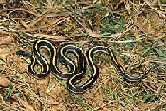 Garter snake~ Harmless snake of the genus Thamnophis.
Garter snake~ Harmless snake of the genus Thamnophis.
- Abundant from Canada to Central America. Garter snakes are classified in
the phylum Chordata, subphylum Vertebrata, class Reptilia, order Squamata,
family Colubridae.
- There are many common species; members of most species are about 2 ft
long. Most garter snakes are striped or banded lengthwise, and some are
spotted between the stripes. The common garter snake of the NE United States,
Thamnophis sirtalis, varies in color and pattern but is usually blackish or
brownish with three yellow stripes. The ribbon snake, T. sauritus, is a very
slender garter snake that prefers wet places.
- Less aquatic as a group than the related water snakes, they are found near
water in dry country and are widely distributed in moist regions. They prey on
cold-blooded animals, chiefly frogs, toads, small fish, and earthworms.
- Females bear live young in large litters, sometimes numbering 50 or
more.
Boa~ Name for live-bearing constrictor snakes of the family Boidae, found
mostly in the Americas.
- Best known is the boa constrictor (Constrictor constrictor), which lives
in a variety of terrestrial habitats from S Mexico to central Argentina. This
family, which also comprises the egg-laying pythons of the Old World, includes
the largest of all snakes, as well as many smaller ones. Over 30 boa species
are found from Mexico to South America, with the greatest variey in the
tropics, and two in the United States.
- Members of the boa family have two functional lungs instead of one, as is
found in other snakes, and vestiges of hind limbs; these primitive
characteristics are indicative of their relationship to lizards. It averages 6
to 9 ft in length, occasionally reaching 14 ft , and has dark brown diamond
markings on a lighter background. Each of the two tiny, internal leg bones
ends in an external horny claw; the claws are much more prominent in males
than in females. Boas may be terrestrial, arboreal, or burrowing. Some are
brightly colored, like the green and white emerald tree boa of the tropics
(Boa canina), or iridescent, like the wide-ranging rainbow boa (Epicrates
cenchris).
- Boas capture their prey by striking with their teeth and simultaneously
throwing their bodies in a coil around the victim. They then squeeze the
animal so that, unable to expand its rib cage, it suffocates. Like other
snakes, boas swallow the prey whole.
- The South American anaconda (Eunectes murinus) is a semiaquatic boa that
inhabits swamps and river shallows, catching animals that come to drink. The
longest member of the boa family and the thickest of all snakes, it may reach
25 ft in length and 3 ft in girth.
- The rubber boa (Charina bottae) is found in moist regions of the far W
United States and extreme SW Canada. It is a burrower, about 18 in. long, with
a narrow, blunt head, broad, blunt tail, and silver-green skin. It feeds
chiefly on lizards and rodents. The rosy boa (Lichanura roseofusca) is found
in chaparral in the SW United States and N Mexico; it grows about 3 ft long.
It has large, dark brown spots on a lighter background. Several species of
sand boa (Eryx) are distributed from India and central Asia to N Africa and SE
Europe; all are burrowers in sand. There are also several boa species on
Madagascar and several on Pacific islands. Boas are classified in the phylum
Chordata, subphylum Vertebrata, class Reptilia, order Squamata, family
Boidae.
Copperhead~ Poisonous snake, Ancistrodon contortrix, of the
E United States. Copperheads are classified in the phylum Chordata, subphylum
Vertebrata, class Reptilia, order Squamata, family Crotalidae.
- Like its close relative, the water moccasin, the copperhead is a member of
the pit viper family and detects its warm-blooded prey by means of a
heat-sensitive organ behind the nostril. The body, which may reach a length of
4 ft, is hazel brown with chestnut-colored crossbands above and pinkish white
with dark spots below. The head is a pale copper color.
- Copperheads inhabit rocky areas with thick underbrush, even in heavily
populated regions.
- They feed chiefly on small mammals, but will also capture large insects,
frogs, and other snakes.
- They are most active in late afternoon and early evening. The young are
born alive. Copperheads are not aggressive and usually attempt escape when
threatened, but they strike swiftly if startled or attacked. The bite causes
severe pain and illness in humans but is seldom fatal.
 Coral
snake~ Name for poisonous New World snakes of the same family as the Old World
cobras. Coral snakes are classified in the phylum Chordata, subphylum
Vertebrata, class Reptilia, order Squamata, family Elapidae.
Coral
snake~ Name for poisonous New World snakes of the same family as the Old World
cobras. Coral snakes are classified in the phylum Chordata, subphylum
Vertebrata, class Reptilia, order Squamata, family Elapidae.
- About 30 species inhabit Mexico, Central America, and N South America; two
are found in the United States.
- The Eastern coral snake (Micrurus fulvius), or harlequin snake, is found
in the SE United States and N Mexico. It is a burrowing snake with a small,
blunt head and a cylindrical body, averaging 2 1/2 ft in length. The body is
ringed with bands of black, red, and yellow; the tail has yellow and black
rings only.
- The Sonoran, or Western, coral snake (Micruroides euryxanthus) is a rather
rare species found in the SW United States and NW Mexico. It is about 18 in.
long and has much broader bands of yellow than those of the Eastern species.
- Coral snakes can be distinguished from a number of similarly colored
harmless snakes by the fact that they are the only ones with red bands
touching yellow ones. The venom of coral snakes, like that of cobras, acts on
the nervous system and causes paralysis; the mortality rate among humans who
are bitten is high. However, coral snakes are infrequently encountered because
of their burrowing habits, and they seldom bite unless handled. They feed on
other snakes and on lizards.
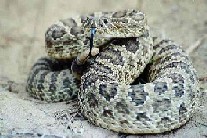 Rattlesnake~ Poisonous New World snake of the pit viper family, distinguished by
a rattle at the end of the tail. Most species are classified in the genus
CrotalusRattlesnakes are classified in the phylum Chordata, subphylum
Vertebrata, class Reptilia, order Squamata, family Crotalidae.
Rattlesnake~ Poisonous New World snake of the pit viper family, distinguished by
a rattle at the end of the tail. Most species are classified in the genus
CrotalusRattlesnakes are classified in the phylum Chordata, subphylum
Vertebrata, class Reptilia, order Squamata, family Crotalidae.
- It is from 3 1/2 to 5 ft long and is yellow or tan with wide, dark
crossbands. The head is triangular, being widened at the base. The rattle is a
series of dried, hollow segments of skin, which, when shaken, make a whirring
sound. Like other pit vipers, they have heat-sensitive organs in pits on the
sides of the head, which help them locate and strike at their prey. The
erectile fangs are folded back in the mouth, except when the snake strikes.
- When the snake is alarmed, it shakes its tail, and the noise serves as a
warning to the attacker. While the snake is young, three or four segments are
usually added each year, one at each molt. After maturity fewer develop and
old ones start to break off.
- Rattlesnakes feed on rodents, birds, and other warm-blooded animals.
- The venom is highly toxic to humans and occasionally proves fatal..
Rattlesnakes bear live young.
- The timber rattlesnake, C. horridus, is found from S Maine to NE Florida
and W to Iowa and Texas.
- The largest and deadliest species is the eastern diamondback rattlesnake,
C. adamanteus, of the S and SE United States, which reaches a length of 5 to 8
ft. The western diamondback, C. atrox, is shorter and thicker.
- The western, or prairie, rattlesnake, C. viridis, sometimes lives in
prairie-dog burrows.
- The sidewinder, C. cerastes, is a North American desert species.
- The approximately 30 Crotalus species range from S Canada to N Argentina.
- The genus Sistrurus comprises the three pygmy rattlesnake species of the
United States and Mexico.
- The smallest, S. miliarius, of the SE United States, is under 18 in.
long.
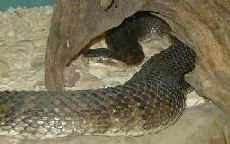 Water moccasin or cottonmouth~ Highly venomous snake, Ancistrodon piscivorus, of
the swamps and bayous of the S United States. It is classified in the phylum
Chordata, subphylum Vertebrata, class Reptilia, order Squamata, family
Crotalidae.
Water moccasin or cottonmouth~ Highly venomous snake, Ancistrodon piscivorus, of
the swamps and bayous of the S United States. It is classified in the phylum
Chordata, subphylum Vertebrata, class Reptilia, order Squamata, family
Crotalidae.
- Like the closely related copperhead, it is a pit viper and has a
heat-sensitive organ for detecting warm-blooded prey.
- The young are born live. The young snake is a pale reddish brown with
transverse dark brown bands edged with white; as it ages the colors dull to a
blotched olive or brown and then to an unmarked olive or blackish in old
specimens. The maximum length is 6 ft, the average from 3 to 4 ft.
- A good climber, the water moccasin often relaxes on branches overhanging
the water. If startled it erects its head and shows the white interior of its
mouth—hence the name cottonmouth.
- It eats both warm-blooded and cold-blooded animals. It is aggressive in
the wild state but may become quite tame in captivity.
Python~ Name for nonvenomous constrictor snakes of the boa family, found in
the tropical regions of Africa, Asia, Australia, and the S Pacific islands.
Pythons are classified in the phylum Chordata, subphylum Vertebrata, class
Reptilia, order Squamata, family Boidae.
- Pythons climb and swim expertly. It is often found in towns as well as in
the forest.
- They kill the birds and mammals on which they feed by squeezing them in
their coils.
- Unlike boas, pythons are egg layers. The female coils her body over the
eggs for the six to eight week incubation period.
- The reticulated, or royal, python, Python reticulatus, of SE Asia,
Indonesia, and the Philippines is one of the largest snakes in the world and
may reach a length of 30 ft or more.
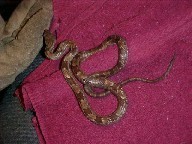 Rat snakes~ The rat snakes of the genus Elaphe include some forty
or more species of harmless snakes in Europe, Asia, the Malaysian Archipelago,
and North America south to Costa Rica. Not all of the species are explicitly
called rat snakes; a wide variety of common names have been applied, including
fox snake (Elaphe vulpina) and corn snake (Elaphe guttata). In addition to the
genus Elaphe, there are several other genera, including Spilotes, Pryas, and
Gonyosoma, that are commonly called 'rat snakes." In general, the care of these
other "rat snakes" is similar to that of the genus Elaphe.
Rat snakes~ The rat snakes of the genus Elaphe include some forty
or more species of harmless snakes in Europe, Asia, the Malaysian Archipelago,
and North America south to Costa Rica. Not all of the species are explicitly
called rat snakes; a wide variety of common names have been applied, including
fox snake (Elaphe vulpina) and corn snake (Elaphe guttata). In addition to the
genus Elaphe, there are several other genera, including Spilotes, Pryas, and
Gonyosoma, that are commonly called 'rat snakes." In general, the care of these
other "rat snakes" is similar to that of the genus Elaphe.
- The head of the typical rat snake is rather long, with a squared-off
snout, and the eye is moderately large with a round pupil. The body scales are
smooth along the sides and smooth or faintly keeled along the back. In most
species the outer edges of the belly scales are angled to form ridges running
along the base of each flank. This is an aid to climbing, and they are
generally excellent climbers. All species are egg layers. The general size
range of adults in the various species is between 3 and 6', though a few
species rarely reach 3' and some others often exceed 6'. They are moderately
slender, but well muscled, and kill their prey by constriction.
- Adult rat snakes feed primarily on small mammals and birds. They are also
well known for eating bird eggs, although in captivity they often show no
interest in hens' eggs, possibly because commercially processed eggs do not
retain their natural odor. Juvenile specimens will eat warm-blooded prey if it
is small enough and even the smallest hatchling can swallow a newborn pinky
mouse. The juveniles in particular will also eat cold-blooded items, including
other snakes, lizards, fish, frogs, and even insects.
Home 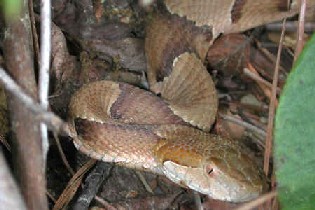
My Take On Snakes:snakes --created by Valarie Dannels,
valarie_anne68@yahoo.com
last modified September 16, 2004
--URL: index.html
 Garter snake~ Harmless snake of the genus Thamnophis.
Garter snake~ Harmless snake of the genus Thamnophis.
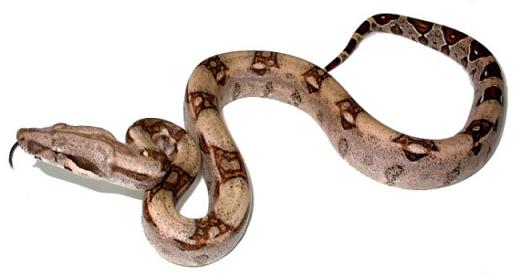
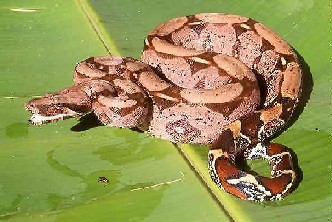
 Garter snake~ Harmless snake of the genus Thamnophis.
Garter snake~ Harmless snake of the genus Thamnophis.
 Coral
snake~ Name for poisonous New World snakes of the same family as the Old World
cobras. Coral snakes are classified in the phylum Chordata, subphylum
Vertebrata, class Reptilia, order Squamata, family Elapidae.
Coral
snake~ Name for poisonous New World snakes of the same family as the Old World
cobras. Coral snakes are classified in the phylum Chordata, subphylum
Vertebrata, class Reptilia, order Squamata, family Elapidae.
 Rattlesnake~ Poisonous New World snake of the pit viper family, distinguished by
a rattle at the end of the tail. Most species are classified in the genus
CrotalusRattlesnakes are classified in the phylum Chordata, subphylum
Vertebrata, class Reptilia, order Squamata, family Crotalidae.
Rattlesnake~ Poisonous New World snake of the pit viper family, distinguished by
a rattle at the end of the tail. Most species are classified in the genus
CrotalusRattlesnakes are classified in the phylum Chordata, subphylum
Vertebrata, class Reptilia, order Squamata, family Crotalidae.
 Water moccasin or cottonmouth~ Highly venomous snake, Ancistrodon piscivorus, of
the swamps and bayous of the S United States. It is classified in the phylum
Chordata, subphylum Vertebrata, class Reptilia, order Squamata, family
Crotalidae.
Water moccasin or cottonmouth~ Highly venomous snake, Ancistrodon piscivorus, of
the swamps and bayous of the S United States. It is classified in the phylum
Chordata, subphylum Vertebrata, class Reptilia, order Squamata, family
Crotalidae.
 Rat snakes~ The rat snakes of the genus Elaphe include some forty
or more species of harmless snakes in Europe, Asia, the Malaysian Archipelago,
and North America south to Costa Rica. Not all of the species are explicitly
called rat snakes; a wide variety of common names have been applied, including
fox snake (Elaphe vulpina) and corn snake (Elaphe guttata). In addition to the
genus Elaphe, there are several other genera, including Spilotes, Pryas, and
Gonyosoma, that are commonly called 'rat snakes." In general, the care of these
other "rat snakes" is similar to that of the genus Elaphe.
Rat snakes~ The rat snakes of the genus Elaphe include some forty
or more species of harmless snakes in Europe, Asia, the Malaysian Archipelago,
and North America south to Costa Rica. Not all of the species are explicitly
called rat snakes; a wide variety of common names have been applied, including
fox snake (Elaphe vulpina) and corn snake (Elaphe guttata). In addition to the
genus Elaphe, there are several other genera, including Spilotes, Pryas, and
Gonyosoma, that are commonly called 'rat snakes." In general, the care of these
other "rat snakes" is similar to that of the genus Elaphe.
